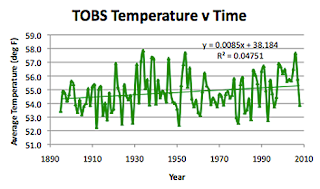Since then the style of the presentations has changed a little bit, so I am going to redo the Kansas post, and just put the combined temperature reference into the list down the right side of the site, so as to bring it (and later some of the other states) into the same format as I have now evolved. So to begin , Kansas has 31 USHCN stations, that are reasonably evenly distributed around the state:
 USHCN station locations in Kansas (USHCN)
USHCN station locations in Kansas (USHCN) Back when I did the initial TOBS data analysis I was still sufficiently naïve that I did not realize how, by manipulation of the station picks, GISS could manipulate the temperatures that it reports. Chiefio has explained both how the current selection raises the overall U..S.A. station record by 0.6 deg C, over the USHCN average, by selective deletion of stations, for 2008, for example. There is also a new set of 59 GISS stations that have been added, but these do not have the historic data that I have been comparing to, so I am going to ignore those additions for the rest of this series. However there is one additional point that this study has brought out about how NASA shall we say “fudges” their data.
I first mentioned, when looking at Idaho’s temperatures, the GISS habit of marrying a short-term station with a long-term one. E.M. Smith (Chiefio) has done a detailed post explaining how, by using this type of combination it is possible to generate a trend that does not exist in the initial data. What has since been interesting, as I have continued with this series, is finding just how many state temperature situations that applies to. And the first one that I noticed, but not then realizing the reason, was Kansas, the second state that I had looked at There are 5 GISS stations on the list, including Witchita , Topeka, Concordia,, Dodge City and Goodland. It is Goodland that only has data since 1948.
 Goodland KS GISS station data
Goodland KS GISS station dataBecause of the small number of stations, the impact of the partial temperature record is significant on the relative difference between the GISS and USHCN average values (using the homogenized USHCN data for this)
 Difference between the average GISS station temperature and that of the homogenized USHCN stations
Difference between the average GISS station temperature and that of the homogenized USHCN stationsTurning to the TOBS data, and looking at the average temperature change in the state, over time, the temperature rise is 0.85 degrees per century (the homogenized data would suggest a rise of 1.2 degrees.)
 Average TOBS temperatures for Kansas (USHCN)
Average TOBS temperatures for Kansas (USHCN) The geography of Kansas is that it is 400 miles long and 210 miles wide, running from roughly 94.5 deg W to 102 deg W, and 37 deg N to 40 deg N. The highest point is at 1,231 m, and the average elevation is at 609.6 m. (The average USHCN station is at 511 m and the average GISS station at 586 m).
Looking therefore at the variation in temperature with the geographical parameters of the state:
 Effect of station latitude on recorded temperatures in Kansas
Effect of station latitude on recorded temperatures in KansasThis is a state where the effect of latitude is clearly defined. Given that the state elevation is steadily rising to the West, as we move towards the Rockies it is not surprising that we see:

The stronger and real correlation is with the changing elevation

There was not, in the original search for data, much problem in finding population numbers
 The effect of current population size on average station temperature for Kansas
The effect of current population size on average station temperature for KansasNote that for the curve above, because it is the only source of information for the larger cities in the state, I have included the GISS station data.
And finally there is the difference that shows the effect of USHCN homogenization of the data relative to that recorded and adjusted only for time of observation.

I am replacing the original two posts of Kansas on the comprehensive list with this post so as to give a greater consistency to the formatting.



Topeka employers pay their workers an average of $30,314 annually with the utmost percentile receiving $36,212 and the undermost percentile gets $23,325. Dental Assistant Salary in Kansas
ReplyDeleteThis comment has been removed by a blog administrator.
ReplyDeleteThis comment has been removed by a blog administrator.
ReplyDeleteThis comment has been removed by a blog administrator.
ReplyDeleteThis comment has been removed by a blog administrator.
ReplyDelete